Our Verdict
The Ryzen 5 3600XT is the most interesting of AMD's Matisse refresh, we'd still recommend the original Zen 2 chips in pretty much every situation.
For
- Strong performer
- Zen 2 architecture
- Retains the Wraith Spire cooler
- PCIe Gen 4 support
Against
- Better value can be had elsewhere
- The improvements are subtle
PC Gamer's got your back
The Ryzen 5 3600XT is the third of three XT chips that AMD has just launched, and spoiler alert, it's quite possibly the best one. Although only just. A quick peer at the score will tell you it isn't perfect though, and the reasons for that are many and varied. Ultimately though, it comes down to the fact that a small increase to the boost clock and a refined production process isn't enough to justify a slightly higher price tag over the Ryzen 5 3600X.
Cores: 6
Threads: 12
Base clock: 3.8GHz
Max boost clock: 4.5GHz
L3 Cache: 32MB
Memory support: DDR4 3200MHz
Socket: AM4
TDP: 95 W
Cooler: Wraith Spire
Launch price: $249 (£249)
Unlike the other XT chips that were released a year after AMD introduced its first Zen 2 processors, the Ryzen 5 3600XT does at least still come with a cooler. In this case you get the Wraith Spire model, which lacks the RGB pretties of the top end bundled coolers, but does a decent job of keeping the chip in check. More on this later though.
As we've already said, the 3600XT is slightly pricier than the 3600X, although this is down to the market dropping the price of the 3600X, as on paper at least the two chips ostensibly cost the same, which is $249. You can however pick up the 3600X pretty much everywhere for $224. What does that extra $25 get you? 100MHz on the boost clock, and whatever extra overclocking performance you can squeeze from the chip if you fancy taking on the silicon lottery gods.
That's not a lot for $25, but that's not actually the real problem. The issue with the original 3600X, and something that naturally extends to the 3600XT, is that the 3600 (spot the lack of any suffix) makes for possibly the best value Zen 2 chip there is (although you could argue the Ryzen 5 3300X is even better). It's the reason it's in our best CPU for gaming guide.
You can pick the Ryzen 5 3600 up for around $172, and it offers the same six cores and 12 threads as its namesakes, albeit at a slightly slower base clock of 3.6GHz and boost of 4.2GHz (the 3600X has clocks of 3.8/4.4GHz and the new 3600XT has 3.8/4.5GHz).
Essentially the Ryzen 5 3600XT has got to pull out something special in the performance stakes in order to warrant the price difference ($78) from AMD's mid-range superchip.
CPU benchmarks



You'll notice in the benchmarks that there are two entries for the Ryzen 5 3600XT, one using the same all-in-one cooler we used for testing the other XT chips, and the other uses the bundled Wraith Spire cooler. I'd hazard a guess that the vast majority of people buying this chip are going to want to use the cooler it comes with, although for those buyers, it's interesting to see what difference an AIO can make to the performance.
On that point it's worth noting that during testing we saw the temperatures using the Wraith Spire hit a fairly toasty 87°C, which is just about within the recommended operating temperatures. The AIO cooler meanwhile topped out at 78°C, and as can be seen, did produce slightly better performance at the same time.
The difference is fairly slight though, and when looking at benchmarks, the only test that really shows what the slightly higher boost clock can do is the single-thread Cinebench R20 benchmark. Here there's a notable uplift over the 3600X, although it's worth pointing out that anyone interested in doing 3D rendering probably doesn't want to limit themselves to a single thread. That may not be the point of the test, but the notion carries that the best thing about the Ryzen 5 is its 6-core, 12-thread makeup, not that it's single-thread performance is great. Does this impact gaming in the same way? Time to find out...
Gaming benchmarks
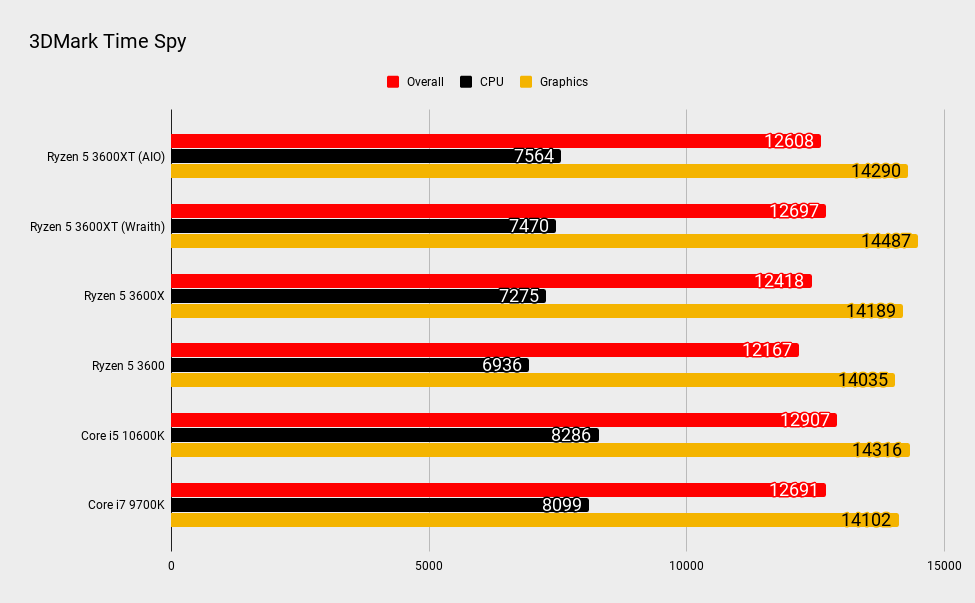
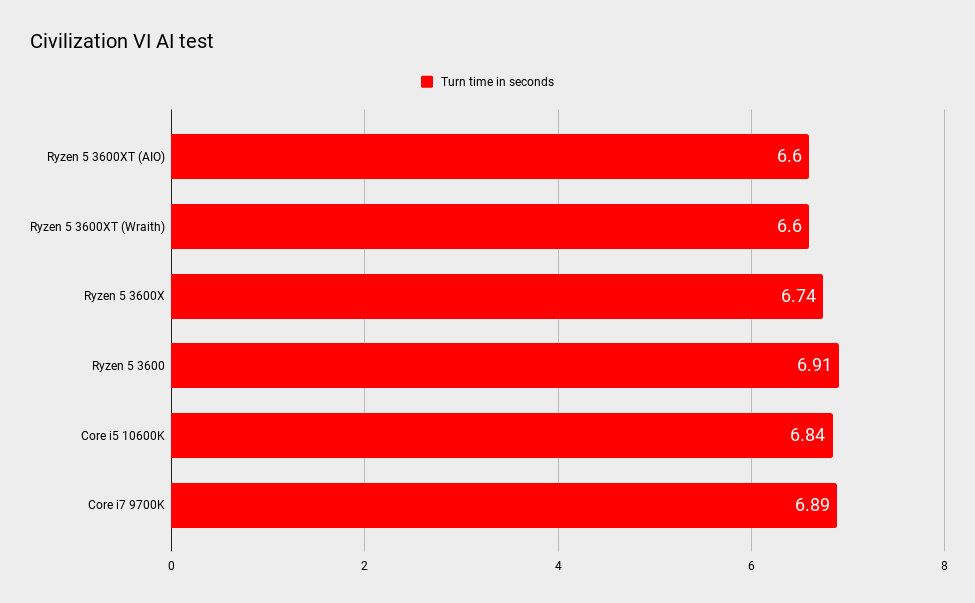
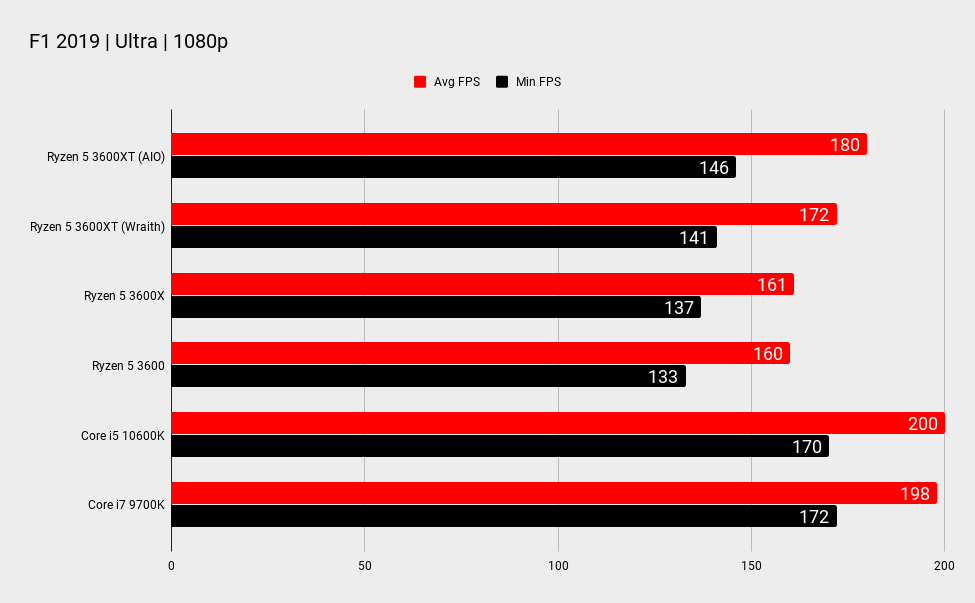
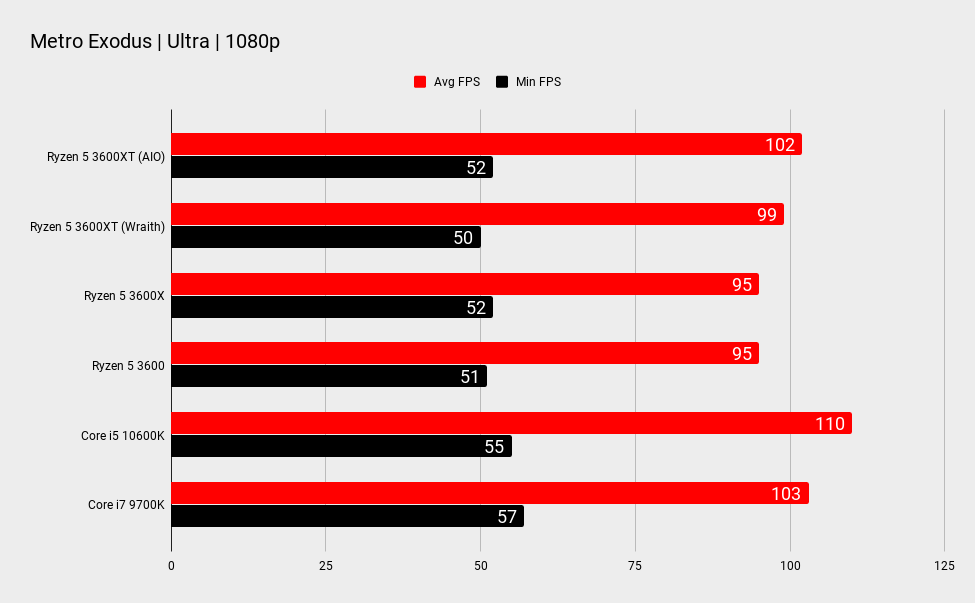
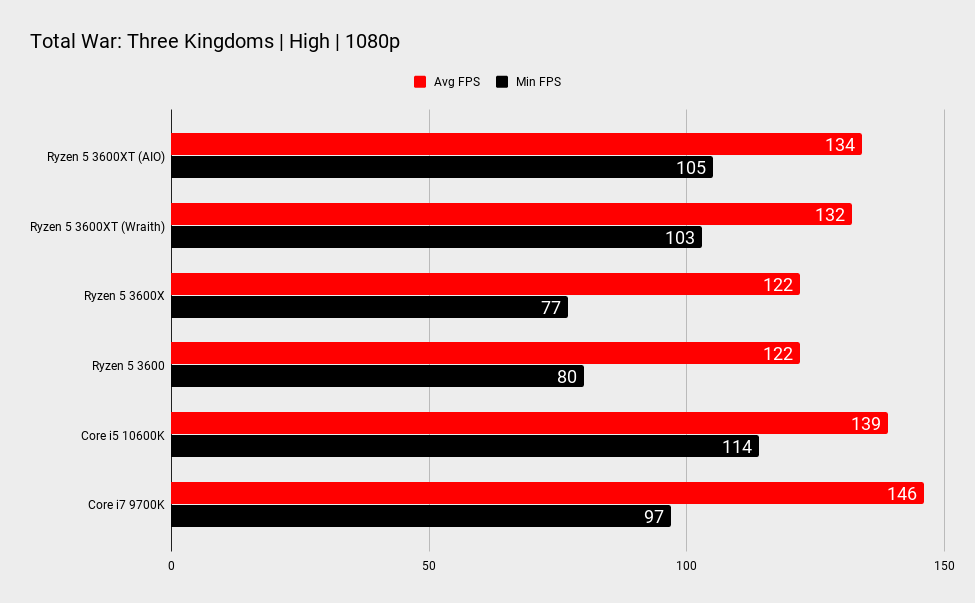


CPU: AMD Ryzen 5 3600XT
Cooler: Wraith Spire and Corsair H115 RGB Pro XT
Motherboard: Gigabyte X570 Aorus Master
Memory: 16GB Thermaltake DDR4 @3600MHz
GPU: Nvidia RTX 2080 Ti
Storage: 2TB Sabrent Rocket PCIe
PSU: Ikonik Vulcan 1200W
The comparison to the 3600X and 3600 does a good job in showing that the 3600XT does indeed represent a noticeable uptick in performance in some games. There's a clear trend between these chips, with the Wraith Spire cooler performance sitting in the gap between the AIO cooler and the 3600X surprisingly well. The F1 2019 results show this particularly well, especially if you look at the minimum frame rates—although to be fair, all these chips can produce incredibly smooth performance on that title.
Not all games show the same performance deltas though, especially as you ramp up the resolution. Far Cry New Dawn at 4K shows hardly any difference between the chips—the onus of 4K performance is entirely on your choice of GPU—and indeed there's only a 3fps difference between the three 3600s and Intel's new Core i5 10600K. So depending on the title you're playing and the resolution you're playing at, you may see anything from a 10% boost compared to the 3600, or nothing at all. The more thread aware the game is, the smaller the performance difference essentially.

The fact that AMD bundled the Wraith Spire cooler with the 3600XT is welcome, and while you can see that more performance (and lower temperatures) can be had by running it with an AIO, such coolers do cost a decent chunk of your budget. When you're at this end of the market, not everyone is going to want to do that. It does give those interested an upgrade path down the line though—upgrade your cooler, and you're pretty much guaranteed higher performance from the off, and that's before even touching overclocking.
Ultimately though, and despite its promise, the Ryzen 5 3600XT suffers the same fate as the Ryzen 9 3900XT and the Ryzen 7 3800XT, in that it simply doesn't do enough to separate it from the chips that came before it. In the case of the 3600XT, the problem is the vanilla Ryzen 5 3600—it's simply an incredible mid-range chip that offers such awesome value for money, that a chip that costs $78 more, but only improves performance by 5% on average, can't really compete. If you want a CPU in the 3600XT's class, then get the Ryzen 5 3600.
The Ryzen 5 3600XT is the most interesting of AMD's Matisse refresh, we'd still recommend the original Zen 2 chips in pretty much every situation.
Alan has been writing about PC tech since before 3D graphics cards existed, and still vividly recalls having to fight with MS-DOS just to get games to load. He fondly remembers the killer combo of a Matrox Millenium and 3dfx Voodoo, and seeing Lara Croft in 3D for the first time. He's very glad hardware has advanced as much as it has though, and is particularly happy when putting the latest M.2 NVMe SSDs, AMD processors, and laptops through their paces. He has a long-lasting Magic: The Gathering obsession but limits this to MTG Arena these days.



